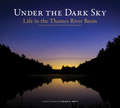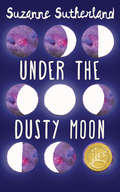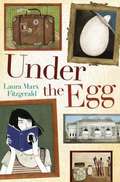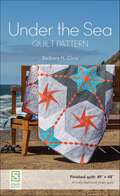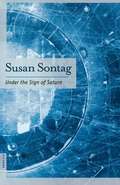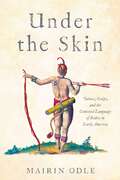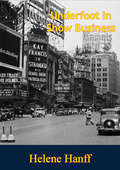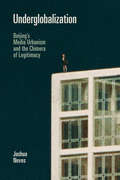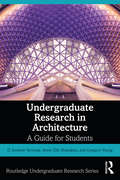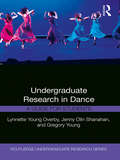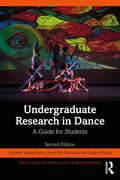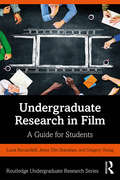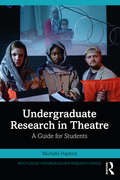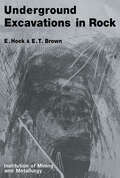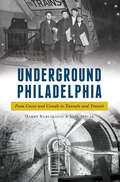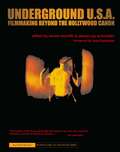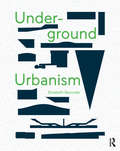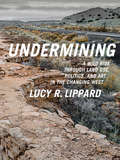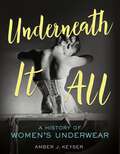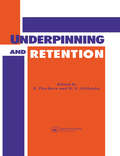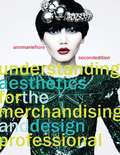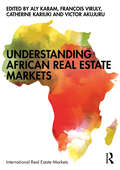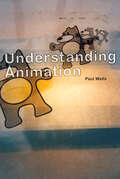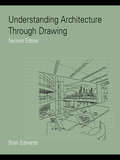- Table View
- List View
Under the Dark Sky: Life in the Thames River Basin
by Steven G. Smith Steve GrantPulitzer Prize-winning photographer Steven G. Smith showcases the picturesque Thames River basin, which extends from southern Massachusetts through Connecticut to the Long Island Sound. The river and its watershed help define the borders of a valley that is unique among its East Coast neighbors, considered to be the last place where dark night sky can be viewed between Washington, D.C. and the Boston metro area. Locals like to call the area the “Quiet Corner” or the “Last Green Valley.” In 1994, the U.S. Congress designated parts of the area as a Natural Heritage Corridor because it is one of the last remaining stretches of green in the area and boasts some of the largest unbroken forests in southern New England. This full-color documentary photo essay explores this Atlantic gem, through the faces of the people and the landscapes. An excellent gift and an educational resource, the book includes a foreword by noted outdoor writer Steve Grant.
Under the Dusty Moon
by Suzanne Sutherland2016 Junior Library Guild Selection 2016 VOYA Top Shelf Fiction Selection CCBC’s Best Books for Kids & Teens (Fall 2016) — Commended She’s with the band, whether she likes it or not. Victoria Mahler is the sixteen-year-old only daughter of rocker Micky Wayne, whose band, Dusty Moon, took the world by storm when Micky was just a teenager. The band broke up under mysterious circumstances, but, after years spent off the road being a mom, Micky’s solo career is finally starting to take off. When an offer to tour Japan falls into her mom’s lap, Vic is left to spend the summer under the care of her distant grandmother, and without her built-in best friend. Fortunately, a boy with a secret geek side and a group of feminist game-makers save the season, and Vic starts to see herself as her own person, out from under her mother’s shadow. But when Micky finally comes home — with a poorly chosen boyfriend in tow — all bets are off. Will Vic be able to maintain her newfound sense of self amidst the building thunder of Micky’s second chance at stardom? And through it all, will Micky still really be her best friend?
Under the Egg
by Laura Marx FitzgeraldFrom the Mixed-Up Files of Mrs. Basil E. Frankweiler meets Chasing Vermeer in this clever middle grade debutWhen Theodora Tenpenny spills a bottle of rubbing alcohol on her late grandfather's painting, she discovers what seems to be an old Renaissance masterpiece underneath. That's great news for Theo, who's struggling to hang onto her family's two-hundred-year-old townhouse and support her unstable mother on her grandfather's legacy of $463. There's just one problem: Theo's grandfather was a security guard at the Metropolitan Museum of Art, and she worries the painting may be stolen.With the help of some unusual new friends, Theo's search for answers takes her all around Manhattan, and introduces her to a side of the city--and her grandfather--that she never knew. To solve the mystery, she'll have to abandon her hard-won self-reliance and build a community, one serendipitous friendship at a time.
Under the Sea Quilt Pattern
by Barbara H. ClineStars, pinwheels, and diamonds. Oh my! Best-selling quilt designer Barbara Cline teaches you her fail-proof method for piecing diamond chains from strip sets. Alternate two triangle blocks in different colors to form attractive stars and pinwheels where the angles meet. Full-size template patterns and detailed instructions guide you in constructing this dynamic diamond-chain quilt. Learn how to piece diamond chains from strip sets 49" x 48" finished quilt with complete instructions and templates Wholesale minimum: 3 units.
Under the Sign of Saturn
by Susan SontagThis third essay collection by America's leading essayist brings together her most important critical writing from 1972 to 1980, in which she explores some of the most influential artists and thinkers of our time.
Under the Skin: Tattoos, Scalps, and the Contested Language of Bodies in Early America (Early American Studies)
by Mairin OdleUnder the Skin investigates the role of cross-cultural body modification in seventeenth-century and eighteenth-century North America, revealing that the practices of tattooing and scalping were crucial to interactions between Natives and newcomers. These permanent and painful marks could act as signs of alliance or signs of conflict, producing a complex bodily archive of cross-cultural entanglement.Indigenous body modification practices were adopted and transformed by colonial powers, making tattooing and scalping key forms of cultural and political contestation in early America. Although these bodily practices were quite distinct—one a painful but generally voluntary sign of accomplishment and affiliation, the other a violent assault on life and identity—they were linked by growing colonial perceptions that both were crucial elements of “Nativeness.” Tracing the transformation of concepts of bodily integrity, personal and collective identities, and the sources of human difference, Under the Skin investigates both the lived physical experience and the contested metaphorical power of early American bodies.Struggling for power on battlefields, in diplomatic gatherings, and in intellectual exchanges, Native Americans and Anglo-Americans found their physical appearances dramatically altered by their interactions with one another. Contested ideas about the nature of human and societal difference translated into altered appearances for many early Americans. In turn, scars and symbols on skin prompted an outpouring of stories as people debated the meaning of such marks. Perhaps paradoxically, individuals with culturally ambiguous or hybrid appearances prompted increasing efforts to insist on permanent bodily identity. By the late eighteenth century, ideas about the body, phenotype, and culture were increasingly articulated in concepts of race. Yet even as the interpretations assigned to inscribed flesh shifted, fascination with marked bodies remained.
Underfoot In Show Business
by Helene HanffIn her spirited, witty and vastly entertaining memoir, Helene Hanff recalls her ingenuous attempts to crash Broadway in the early forties as one of “the other 999.”Naive, nearsighted, frequently penniless but hopelessly stagestruck, she found her life governed by Flanagan’s Law: “No matter what happens to you, it’s unexpected.” Therefore, as a prize-winning Theatre Guild protégée with a brilliant future, Helene naturally found that all the producers who were going to produce her plays didn’t, and all the agents who were going to sell her plays couldn’t.Together with her best friend Maxine, an aspiring actress consigned to playing the comedy-ingénue in plays that regularly folded after five performances, she cultivated the “delicate, illegal art of getting everything for nothing”—from free seats to every Broadway show and neighborhood movie and borrowed outfits from Saks to voice lessons for Maxine and Greek lessons for Helene. To keep body and soul together until Broadway fame arrived, they devised an economic survival system that embraced such unlikely jobs as taking street-corner.Reviews — “Miss Hanff, having a good memory and a lively sense of humor, has composed a theater sketch that is realistic as well as hilarious....One of the most amusing recent theater books about the Broadway theater.”—Brooks Atkinson“A delightful book by an irrepressible author....What really lifts the book to a high level of entertainment is the sparkling humor. To describe the incidents wouldn’t do justice to the book’s charm which comes from the style of writing and Miss Hanff’s boundless optimism.”—Library Journal“A gay and entertaining book which also has substance.”—Boston Herald“Hilarious and highly successful. If you need cheering up, this is it. Here’s hoping Miss Hanff finds more failures to write books about.”—Columbus Dispatch
Underglobalization: Beijing's Media Urbanism and the Chimera of Legitimacy
by Joshua NevesDespite China's recent emergence as a major global economic and geopolitical power, its association with counterfeit goods and intellectual property piracy has led many in the West to dismiss its urbanization and globalization as suspect or inauthentic. In Underglobalization Joshua Neves examines the cultural politics of the “fake” and how frictions between legality and legitimacy propel dominant models of economic development and political life in contemporary China. Focusing on a wide range of media technologies and practices in Beijing, Neves shows how piracy and fakes are manifestations of what he calls underglobalization—the ways social actors undermine and refuse to implement the specific procedures and protocols required by globalization at different scales. By tracking the rise of fake politics and transformations in political society, in China and globally, Neves demonstrates that they are alternate outcomes of globalizing processes rather than anathema to them.
Undergraduate Research in Architecture: A Guide for Students (Routledge Undergraduate Research Series)
by Jenny Olin Shanahan Gregory Young D. Andrew VernooyUndergraduate Research in Architecture: A Guide for Students supplies tools for scaffolding research skills, with examples of undergraduate research activities and case studies on projects in the various areas of architecture study. Undergraduate research has become a common degree requirement in some disciplines and is growing rapidly. Many undergraduate activities in music have components that could be combined into compelling undergraduate research projects, either in the required curriculum, as part of existing courses, or in capstone courses centered on undergraduate research.Following an overview chapter, the next seven chapters cover research skills including literature reviews, choosing topics, formulating questions, citing sources, disseminating results, and working with data and human subjects. A wide variety of sub-disciplines follow in the remaining chapters, with sample project ideas from each as well as undergraduate research conference abstracts. The final chapter is an annotated guide to online resources. Included are some inspirational quotations concerning architecture’s commitment to research, and some examples of professional research that support the focus of the chapter. All chapters end with relevant questions for discussion.
Undergraduate Research in Architecture: A Guide for Students (Routledge Undergraduate Research Series)
by Jenny Olin Shanahan Gregory Young D. Andrew VernooyUndergraduate Research in Architecture: A Guide for Students supplies tools for scaffolding research skills, with examples of undergraduate research activities and case studies on projects in the various areas of architecture study. Undergraduate research has become a common degree requirement in some disciplines and is growing rapidly. Many undergraduate activities in music have components that could be combined into compelling undergraduate research projects, either in the required curriculum, as part of existing courses, or in capstone courses centered on undergraduate research.Following an overview chapter, the next seven chapters cover research skills including literature reviews, choosing topics, formulating questions, citing sources, disseminating results, and working with data and human subjects. A wide variety of sub-disciplines follow in the remaining chapters, with sample project ideas from each as well as undergraduate research conference abstracts. The final chapter is an annotated guide to online resources. Included are some inspirational quotations concerning architecture’s commitment to research, and some examples of professional research that support the focus of the chapter. All chapters end with relevant questions for discussion.
Undergraduate Research in Dance: A Guide for Students (Routledge Undergraduate Research Series)
by Jenny Olin Shanahan Gregory Young Lynnette Young OverbyUndergraduate Research in Dance: A Guide for Students supplies tools for scaffolding research skills alongside examples of undergraduate research in dance scholarship. Dance can be studied as an expressive embodied art form with physical, cognitive, and affective domains, and as an integral part of society, history, and vast areas of interdisciplinary content. To this end, the guidance provided by this book will equip future dance professionals with the means to move the field of dance forward. Chapters 1–9 guide students through the fundamentals of research methods, providing a foundation to help students get started in understanding research protocols and processes. Students will learn skills such as how to choose a research topic, refine research questions, conduct literature reviews, cite sources, synthesize and analyze data, develop conclusions and results, and present their findings. Chapters 10–19 detail forms of undergraduate research in a rich diversity of fields within dance that are taught in many collegiate dance programs including dance therapy, history, science, psychology, education, and technology, in addition to public scholarship, choreography, and interdisciplinary topics. The book also includes a final chapter which provides annotated online resources, and many of its chapters are supported by examples of abstracts of capstone projects, senior theses, and conference presentations by undergraduate researchers across the United States. Suitable for both professors and students, Undergraduate Research in Dance is an ideal reference book for any course that has a significant opportunity for the creation of new knowledge, or as an essential interdisciplinary connection between dance and other disciplines.
Undergraduate Research in Dance: A Guide for Students (Routledge Undergraduate Research Series)
by Jenny Olin Shanahan Gregory Young Lynnette Young OverbyUndergraduate Research in Dance: A Guide for Students supplies tools for scaffolding research skills, alongside examples of undergraduate research in dance scholarship. This second edition has been updated throughout for current students, with new chapters on mentoring and dance studies.Dance can be studied as an expressive embodied art form with physical, cognitive, and affective domains, and as an integral part of society, history, and vast areas of interdisciplinary content. To this end, the guidance provided by this book will equip future dance professionals with the means to move the field of dance forward. Chapters 1–9 guide students through the fundamentals of research methods, providing a foundation to help students get started in understanding research protocols and processes. A new chapter 10 provides guidelines for mentoring undergraduate students in dance. Chapters 11–21 detail forms of undergraduate research in a rich diversity of fields within dance that are taught in many collegiate dance programs including dance therapy, history, science, psychology, education, and technology, in addition to public scholarship, choreography, and interdisciplinary topics. A new chapter on dance studies has been added to this second edition. The book also includes annotated online resources, and many of its chapters are supported by examples of abstracts of capstone projects, senior theses, and conference presentations by undergraduate researchers across the United States and globally.Suitable for both professors and students, this book is an ideal reference book for dance studies as well as humanities and arts courses intersecting with dance.
Undergraduate Research in Film: A Guide for Students (Routledge Undergraduate Research Series)
by Jenny Olin Shanahan Gregory Young Lucia RicciardelliUndergraduate Research in Film: A Guide for Students supplies tools for building research skills, with examples of undergraduate research activities and case studies on projects in the various areas in the study of film, film theory, film production, history of film, and interdisciplinary projects. Professors and students can use it as a text and/or a reference book. Essentially, what makes this volume unique is that it brings together examples of film projects and film studies courses within the framework of research skills. Following an overview chapter, the next seven chapters cover research skills including writing literature reviews, choosing topics and formulating questions,working with human subjects, collecting and analyzing data, citing sources and disseminating results. A wide variety of sub-disciplines follow in chapters 9-16 with sample project ideas from each, as well as undergraduate research conference abstracts. The final chapter is an annotated guide to online resources. All chapters begin with inspiring quotations and end with relevant discussion questions.
Undergraduate Research in Theatre: A Guide for Students (Routledge Undergraduate Research Series)
by Michelle HayfordUndergraduate Research in Theatre: A Guide for Students supplies tools for scaffolding research skills alongside examples of undergraduate research in theatre and performance scholarship. The book begins with an overview of the necessity of framing theatre as undergraduate research and responding to calls for revolutionizing the discipline toward greater equity, diversity, and inclusion. Dedicated chapters for the research, skills, and methods employed by each theatre area follow: scripted theatre; devised and new works; applied theatre; scenic, costume, sound, and lighting design; and theatre theory and interdisciplinary studies. Throughout the book, undergraduate research activities are demonstrated by 36 case studies authored by undergraduates from six countries about diverse areas of theatre study. Suitable for both professors and students, Undergraduate Research in Theatre is an ideal resource for any course that has an opportunity for the creation of new knowledge or as an essential interdisciplinary connection between theatre, performance, and other disciplines.
Underground Excavations in Rock
by E. Hoek E.T. BrownUnderground Excavations in Rock deals with the geotechnical aspects of the design of underground openings for mining and civil engineering processes.
Underground Philadelphia: From Caves and Canals to Tunnels and Transit
by Harry Kyriakodis Joel SpivakPhiladelphia's relationship with the underground is as old as the city itself, dating back to when Quaker settlers resided in caves alongside the Delaware River more than three hundred years ago. The City of Brotherly Love later became a national and world leader in the delivery of water, gas, steam, and electricity during the industrial age. The construction of multiple subway lines within Center City took place during the early twentieth century. An intricate subsurface pedestrian concourse was also developed throughout the downtown area for the city's inhabitants. From Thirtieth Street Station and Reading Terminal to the Commuter Rail Tunnel and transit lines that were never built, Philadelphia's infrastructure history is buried under the earth as much as above. Join authors Harry Kyriakodis and Joel Spivak as they reveal the curious aspects of the Quaker City's underground experience.
Underground U.S.A.: Filmmaking Beyond the Hollywood Canon (Alterimage)
by Xavier Mendik Steven Jay Schneider Lloyd KaufmanWhether defined by the carnivalesque excesses of Troma studios (The Toxic Avenger), the arthouse erotica of Radley Metzger and Doris Wishman, or the narrative experimentations of Abel Ferrara, Melvin Van Peebles, Jack Smith, or Harmony Korine, underground cinema has achieved an important position within American film culture. Often defined as "cult" and "exploitation" or "alternative" and "independent," the American underground retains separate strategies of production and exhibition from the cinematic mainstream, while its sexual and cinematic representations differ from the traditionally conservative structures of the Hollywood system. Underground U.S.A. offers a fascinating overview of this area of maverick moviemaking by considering the links between the experimental and exploitative traditions of the American underground.
Underground Urbanism
by Elizabeth ReynoldsHave you ever wondered what lies beneath the streets of your city? Do you picture, in isolation, a series of train tunnels and pipes? Or perhaps the foundations of tall buildings that lie scattered, like icebergs, beneath the surface? As our cities grow up, out, and down, it is time we better understood how the different layers of these complex urban environments relate to one another. Underground Urbanism seeks to provide a new perspective on our cities, and consider how this might be used to engage more positively with them. So, tip your cities upside down to have a closer look, and let us rethink them from (below) the ground, up.
Undermining: A Wild Ride Through Land Use, Politics, and Art in the Changing West
by Lucy R. Lippard&“A marvelous slim book [that] weaves . . . ideas, facts, images, and histories into a whole about . . . the ecology of the manmade world.&” —Rebecca Solnit In Undermining, the award-winning author, art historian and social critic Lucy R. Lippard delivers &“another trademark work&” that combines text and full-color images to explore &“the intersection of art, the environment, geography and politics&” (Kirkus Reviews). Working from her own experience of life in a New Mexico village, and inspired by the gravel pits in the surrounding landscape, Lippard addresses a number of fascinating themes—including fracking, mining, land art, adobe buildings, ruins, Indian land rights, the Old West, tourism, photography, and water. In her meditations, she illuminates the relationship between culture, industry, and the land. From threatened Native American sacred sites to the history of uranium mining, she offers a skeptical examination of the &“subterranean economy.&” Featuring more than two hundred gorgeous color images, Undermining offers a provocative new perspective on the relationship between art and place in a rapidly shifting society. &“[Lippard&’s] strength lies in the depth of [her] commitment—her dual loyalty to tradition and modernity and her effort to restore the broken connection between the two.&” —Suzi Gablik, The New York Times Book Review
Underneath It All: A History of Women's Underwear
by Amber J. KeyserFor most of human history, the garments women wore under their clothes were hidden. The earliest underwear provided warmth and protection. But eventually, women's undergarments became complex structures designed to shape their bodies to fit the fashion ideals of the time. In the modern era, undergarments are out in the open, from the designer corsets Madonna wore on stage to Beyoncé's pregnancy announcement on Instagram. This feminist exploration of women's underwear reveals the intimate role lingerie plays in defining women's bodies, sexuality, gender identity, and body image. It is a story of control and restraint but also female empowerment and self-expression. You will never look at underwear the same way again.
Underpinning and Retention
by S. Thorburn G. S. LittlejohnVarious underpinning methods exist, and choosing a particular method or selection of methods is the job of the engineer. Consistent with the underpinning procedure is the need to retain the affected structure plus the surrounding ground and/or buildings. This book will offer advice on how to chose the correct procedure.
Understanding Aesthetics for the Merchandising and Design Professional
by Ann FioreBridging the gap between the study of aesthetics and its application in the merchandising and design environments, the 2nd Edition of Understanding Aesthetics presents a research-based focus on the concepts of aesthetics and their effect on product value and consumer behavior. The multisensory approach to studying the elements and principles of design helps students master the underlying factors of successful design and learn how products and their promotional surroundings can establish brand identity and create a pleasing environment for the consumer.
Understanding African Real Estate Markets (Routledge International Real Estate Markets Series)
by Aly Karam François Viruly Catherine Kariuki Victor A. AkujuruThis book brings together a broad range of research that interrogates how real estate market analysis, finance, planning, and investment for residential and commercial developments across the African continent are undertaken. In the past two decades, African real estate markets have rapidly matured, creating the conditions for new investment opportunities which has increased the demand for a deeper understanding of the commercial and residential markets across the continent. The chapters consider issues that pertain to formal real estate markets and the critical relationship between formal and informal property markets on the continent. With contributing authors from South Africa, Ghana, Nigeria, Uganda, Kenya, and Tanzania, the book considers the achievements of African real estate markets while also highlighting the complex central themes such as underdeveloped land tenure arrangements, the availability of finance in both the commercial and residential sectors, rapidly growing urban areas, and inadequate professional skills. This book is essential reading for students in real estate, land management, planning, finance, development, and economics programs who need to understand the nuances of markets in the African context. Investors and policy makers will learn a lot reading this book too.
Understanding Animation
by Paul WellsFirst Published in 1998. Routledge is an imprint of Taylor & Francis, an informa company.
Understanding Architecture Through Drawing
by Brian EdwardsThis second edition is fully revised and updated and includes new chapters on sustainability, history and archaeology, designing through drawing and drawing in architectural practice. The book introduces design and graphic techniques aimed to help designers increase their understanding of buildings and places through drawing. For many, the camera has replaced the sketchbook, but here the author argues that freehand drawing as a means of analyzing and understanding buildings develops visual sensitivity and awareness of design. By combining design theory with practical lessons in drawing, Understanding Architecture Through Drawing encourages the use of the sketchbook as a creative and critical tool. The book is highly illustrated and is an essential manual on freehand drawing techniques for students of architecture, landscape architecture, town and country planning and urban design.
